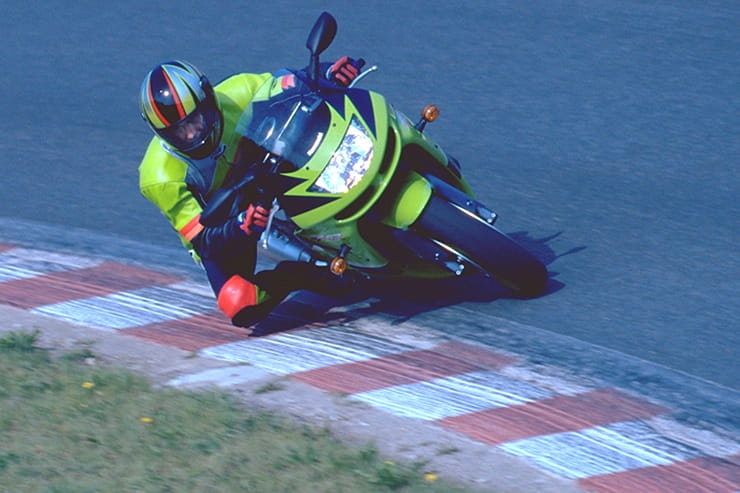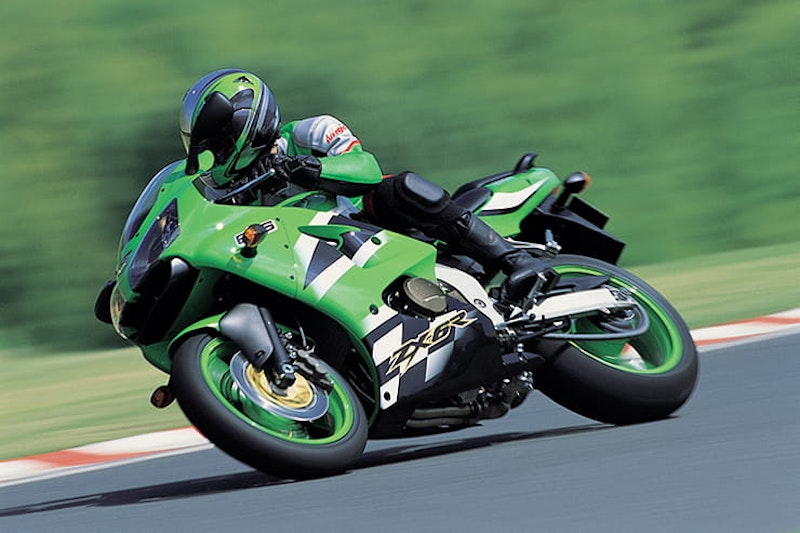Kawasaki ZX-6R (1998-2002): Review & Buying Guide
By Kev Raymond
Motorcycle Journalist
02.06.2020
The 1990s were the heyday of the Supersport 600. Kawasaki had kicked the class off in 1985 with the superb GPZ600R, but the early '90s ZZ-R600 was more sports tourer than supersports. It was fast though, and when the big K went for a full-on Supersport bike with 1995's ZX-6R it used a mildly reworked version of the ZZ-R engine. It was 1998's ZX-6R G1 that really moved the game on though – an all-new chassis, with racetrack-ready suspension and brakes and a smart suit of clothes, housing an even more refined version of that great engine, now making a genuine 100bhp. In that form, it survived for four years, with just a mild update for the J1(2000) and J2 (2001) versions – minor engine upgrades, new swing arm and revised rear shock, tweaked upper fairing and headlight. For 2002, we all expected a whole new model, but Kawasaki made a very clever move, leaving the basic bike more or less unchanged (very slight mods to the front and rear suspension) but boring the engine out to 636cc, a move made possible because the engine had been designed with cast piston liners, but had evolved to use alloy cylinders with an electro coating, which allowed thinner cylinder walls. That gave the 2002 A1P model a real advantage in the low to mid-range compared with all its rivals – up to about 7000rpm, the ZX-R was making about 30 per cent more torque than the Honda CBR or the Yamaha R6, for example, and easily out-grunting the Suzuki GSX-R and Triumph TT. That made it much easier to ride on the road without constant gearbox-stirring. The extra capacity meant the 2002 ZX-6R wasn't eligible for racing in the 600 class, but that didn't matter - the old model was still homologated, and for 2003 there'd be an all-new ZX-6R, available in road-friendly 636cc or track-friendly 600cc (with posh suspension) versions. But for that one year, the A1P was the best road-going 600 you could buy - practical, but still very, very capable on road or track. Nearly two decades on, a ZX-6R still makes a really practical road bike – a real modern classic.
KAWASAKI ZX-6R (1998-2002) Price
The 1998 ZX-6R retailed at £7,250 – the equivalent of nearly thirteen grand today. Suzuki's GSX-R and Yamaha's Thundercat were pretty much the same price, while Honda's CBR was £250 cheaper. These days you can pick up a tatty early example for as little as a grand, but you're better off spending a bit more – a really clean but relatively high miles (30-50k) G model shouldn't be much more than £1500. If you can squeeze a few more shekels out of the piggy bank, you can find really clean ones with less than 10k on the clocks for under two grand (although there are always optimistic dealers asking way more than that for super-shiny examples). If you want a good 636cc A1P model from 2002 though (and why wouldn't you?) you'll be looking at £2500 or more. Be aware that not every 02-plate is an A1P – there were plenty of J2s registered late. The same applies to the A1P - don't limit your search to 2002 registrations, as quite a few A1Ps were registered well into 2003.
Power and torque
It's a supersport 600, so it's never going to be pulling tree stumps for fun, but having said that, it's nowhere near such a screamer as, say, an R6 or CBR-R of the same era. The 600 has that kind of loose feel in the midrange, carried over from the ZZ-R and other smaller Kawasakis, as if there's a bit of elastic in the throttle cable, so you wind it on further, wait a bit and then 'ping' - it all arrives in a rush. That means for serious fast riding you need to keep the revs high to avoid that lag, but the rest of the time it's forgiving of clumsy throttle inputs, where fuel injected bikes are often jerky from a closed throttle, for example. The 636cc A1P model has a similar feel, and very similar top end, but there's a useful extra lump of torque lower down, which is just what you want on the road.
Engine, gearbox and exhaust
The engine's tough - very tough. Treat it right and it'll still be running sweetly when the rest of the bike's thoroughly worn out. The only regular problems are worn camchains and tensioners causing top end rattles (although often that turns out to be poorly balanced carbs rather than a mechanical issue – the ZX-6R is very sensitive to this) and possibly camshaft pitting if the bike's been left unused for a long time and then thrashed from cold (oil drains away from the right hand end of the cams if the bike's left on its sidestand). Otherwise the biggest problem you're likely to have is carburettor icing in the cold and damp – often a problem on older Kawasakis. There's a heater circuit for the carbs which can easily become blocked, so that needs flushing, but even so it's a problem, and made worse by modern unleaded, especially cheap supermarket stuff with high ethanol content. try posh branded 98 and see if that helps, otherwise invest in a bottle of Silkolene FST and dose the fuel with that. The gearbox is slick and positive, and just as reliable as the engine. Many owners fit aftermarket silencers, but you really need to get the fuelling sorted by a skilled dyno operator, or you'll risk screwing up the midrange in particular.
KAWASAKI ZX-6R (1998-2002) Economy
Thrash it and you'll be down in the low 30s, but in daily normal use it's easy enough to get 45mpg or more, giving you a decent range from the 18-litre tank. You've got an old-school manual reserve tap to access the last four litres or so, and it can be fiddly to operate on the move, especially with winter gloves – even the owner's manual warns that you need to practice operating the tap to avoid fumbling when it starts spluttering mid-overtake... As with the carb icing issue, you may find that using posher fuel repays the investment with better mpg as well as better throttle response.
Handling, suspension, chassis and weight
Suspension's not the plushest out there, but it was always praised in road tests for its accurate steering and relative composure on bumpy roads. The weak point has always been the rear shock, which is a bit basic (although the 636cc A1P model had a much better-quality rear shock). Twenty years on if it's still got the original shock it's going to be pretty baggy by now. A budget replacement from Hagon or YSS, along with a fork rebuild and new oil, will transform the handling, putting it back to its sweet-steering best.
KAWASAKI ZX-6R (1998-2002) Brakes
Six pot Tokico calipers were the mutt's nuts back in 1998 (well, we thought they were - actually they didn't give any more power than conventional four-pots). But they quickly got a reputation for being prone to corrosion, and hard to bleed properly. The corrosion can be slowed by frequent and meticulous cleaning on the bike, but you still need to completely strip them at intervals, and clean out the grooves where the seals sit. Some owners reckon that removing the master cylinder from the bars and placing it lower than the calipers while bleeding helps encourage any air to escape naturally. Others swear by reverse bleeding (using a big syringe to force fluid into the system from the caliper end). The best bet, though, is to ditch them and fit four-pots – there are several fitments from other Kawasakis as well as various Suzuki versions with the same bolt spacing. Incidentally, the headlight and footrest hangers from an E-model ZX-9R also fit the J1/2 and A1P models.
Electrics
There's always been a bit of an issue with the charging system on these – the alternator in particular. The problem is the clearance between rotor and stator – if it's out by a tiny amount it causes problems. Simply removing and replacing the alternator cover can put it out of tolerance, and you'll need to fit a new gasket to get it happy again. We've heard a few reports of fuel pumps failing at high mileages too. Otherwise there are few fundamental problems but with advancing age we'll be seeing more problems with corroded connectors, poor connections and failing minor components. The sidestand switch is a common culprit - exposure to road crud leads to corroded contacts, which leads to intermittent starting problems and then no start at all – shorting the wires to the switch is a get-you-home fix.
Comfort over distance and touring
The position seemed fairly extreme back in the day but compared with current 600s it's positively roomy and luxurious. Still not really an ideal long-distance pillion bike, and even solo most owners are grateful for spluttering onto reserve to give them an excuse to climb off for a while. A re-upholstered seat pad makes a big difference – try Tony Archer in Huddersfield for a bespoke solution.
Rider aids and extra equipment/accessories
If you're looking for an electronic safety net, you've come to the wrong place... The ZX-6R is resolutely old-school – which is why we love it. Few ZXs seem to get heavily accessorised – common sensible mods include a chain oiler and maybe heated grips, but that's about it.
KAWASAKI ZX-6R (1998-2002) verdict
The ZX-6R was always good, but in some ways these days it's even better. Why? Well, freed up from having to pretend to be a race bike, it can get on with being the great road bike it's always been, and in the hands of more mature owners, they're more likely to get the care and attention they need to keep then looking and feeling fresh and crisp. Access to more modern suspension components and setup also makes a huge difference – talk to www.mctsuspension.co.uk to get an idea of what can be done to bring a ZX up to date without breaking the bank. Hidden crash damage used to be a big problem for buyers back when a ZX-6R was more likely to be thrashed on track, but that's less of an issue now (although you should still check around the headstock for flaking pain and evidence of cracking or distortion). In its trackday heyday the ZX was very nickable too, so there were plenty of dodgy ringers out there - again, that's less likely to be a problem today. And neglected bikes always quickly showed evidence of flaky paint and general tattiness – anything that looks clean and standard now has obviously been well cared for and you should be able to keep it that way. All in all, any clean, well cared-for ZX-6R is unlikely to lose you a lot of money over the next few years if you keep it nice, and you should be more concerned about overall condition rather than age and mileage. We'd say try and get a 636cc A1P if you can, though – that extra midrange is well worth paying a bit extra for. If you want to do a bit more research before buying, we'd recommend lurking on the forums at www.zx6r.com for a while. They've also got a good downloads section for manuals etc.
Three things we love about the Kawasaki ZX-6R…
Relative comfort
Proper Kawasaki airbox scream,
The extra drive from the 636cc version
Three things that we don’t…
Slightly iffy finish if neglected
Brakes need lots of maintenance
Carb icing problems
KAWASAKI ZX-6R (1998-2002) spec (J1/2 model quoted)
Looking for motorbike insurance? Get a quote for this bike with Bennetts motorcycle insurance

